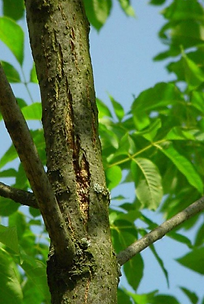Oregon Ash & Emerald Ash Borer
Oregon Ash (Fraxinus latifolia)


The Oregon Ash tree (Fraxinus latifolia) is found primarily in the Pacific Northwest in the areas of Oregon, Washington, and Northern California. It thrives in moist areas such as along streams, wetlands, and floodplains. The Oregon Ash tree is recognizable by their opposite and pinnately compound leaves. They are also known to grow between 60- 80 ft tall, have broad, rounded canopies, and furrowed brown/gray bark.
The trees play a crucial role in stabilizing stream banks and filtering pollutants and excess nutrients, as well as adding to the area's extensive biodiversity. Unfortunately, the trees are facing a serious threat from the invasive Emerald Ash Borer (EAB). This beetle destroyed ash populations in other parts of the U.S and has recently been detected in Oregon. It poses a major concern for the future of Oregon ash and the ecosystems it supports.
Emerald Ash Borer (Agrilus plannipenis)

Image Credit: Village of Mukwonago Public Works
The Emerald Ash Borer (EAB) is an invasive beetle that feeds on ash trees (Fraxinus spp.). Their larvae burrow beneath ash bark and eat the phloem of the tree, “girdling” it or cutting off the tree’s ability to circulate nutrients.
Originally from China, EAB was found in Michigan in 2002.
In the two decades since, it has killed millions of ash trees east of the Mississippi.
As of 2022, it was found on the West Coast for the first time, first identified just outside of Portland in the town of Forest Grove, Oregon. According to the USDA, EAB has a mortality rate of more than 99% in North American ash species.
How to Identify EAB Symptoms

Method 1:
Example of S-shaped larval galleries under bark showing signs of EAB larval activity
(Steeck, 2024)

Method 2a:
Example of D-shaped exit holes showing signs of adult EAB presence.
(Steeck, 2024)

Method 2b:
Example woodpecker activity to help differentiate from Method 2a: D-shaped exit holes.
(Steeck, 2024)

Method 3:
Example of a bark split that would show signs of larval EAB activity and potentially expose Method 1: S-shaped galleries.
(Steeck, 2024)

Method 4:
Example of Epicormic shoots that show signs of larval EAB activity.
(Steeck, 2024)

Method 5:
Example of USDA ash canopy ratings as they correlate to percent canopy.
(Steeck, 2024)
